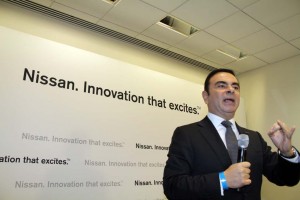Put on the defensive by the slow ramp-up of the maker’s battery cars, Nissan CEO Carlos Ghosn put on a confident face during an appearance at the New York Auto Show and promised this will be a “milestone year” for the Leaf electric vehicle.
With the maker’s second battery-car plant now operating in Smyrna, Tennessee, the executive said inventory is up and demand rapidly growing.
Ghosn, meanwhile, offered a mixed assessment of the global automotive market, pronouncing a bright outlook for the U.S. but more troubles ahead for Europe. He also offered a cautiously upbeat outlook for China.
“This is going to be a milestone year for Leaf,” Ghosn said, maintaining the positive outlook that has positioned him as the most upbeat of the industry’s top executives when it comes to the prospects for vehicle electrification. He continues to forecast that up to 10% of the vehicles sold by decade’s end will use some sort of battery power.
That outlook has come under scrutiny since the Nissan Leaf launched more than two years ago, battery-cars of all forms – from conventional hybrids to full BEVs like Leaf — barely accounting for 3% of the U.S. market, and the Nissan entry missing its American sales goal for the second year in a row.
Ghosn and other Nissan executives have repeatedly insisted the problem has been the lack of availability, the original Japanese battery-car plant struggling to meet demand from markets around the globe. That’s no longer a viable excuse since production began in Tennessee – but demand seems to reflect the increased availability, and while it will be a few more days before final numbers are in hand, Nissan’s North American marketing chief Jose Munoz said the maker expects to move about 1,900 Leaf electrics in the U.S. for March.
The Leaf wasn’t the only Nissan model to miss its mark last year. So did Nissan’s highly touted Altima, weak demand for the midsize sedan constraining the Japanese maker’s overall performance in the U.S. But there are also signs of momentum for Altima, Ghosn and Munoz told reports during an auto show news conference.
That could prove even more critical than Leaf, at least in the near-term. Ghosn has set a target of reaching a “sustainable” 10% market share in the American market, something essential to justify the hefty investments it has made here, he stressed. Last year saw a relatively weak 8%, though the numbers have begun to rebound since the beginning of 2013 and are closing on 9%.
Meanwhile, the U.S. is finally getting into gear after its worse downturn since the Great Recession, Ghosn describing the market as one of the “nice places in the world,” with American sales likely to continue growing through at least 2016.
Not so Europe, where the Brazilian-born executive had a very different forecast, anticipating at least three years of flat to negative growth. That will be particularly challenging for Nissan’s French alliance partner, Renault, though he said he is optimistic it can improve its position in Europe to become the Continent’s second-largest maker after Volkswagen AG.
As for China, Ghosn insisted he remains “very bullish” about what is now the world’s largest automotive market despite growing uncertainty about whether the Chinese can maintain the massive momentum of the last decade.
Nissan is now recovering from an unexpected setback – along with the rest of its Japanese competitors – touched off by a territorial dispute between China and Japan. That led to riots and even the destruction of some Japanese vehicles, as well as a consumer boycott.
“We lost one year in China,” he lamented, though Ghosn said Nissan appears to have regained its momentum and seems positioned to become the largest Japanese maker operating in the Chinese market.
During his discussion with the media, Ghosn also weighed in on the controversy over the sudden rise in Japan’s currency, the yen jumping from less than 80 to the U.S. dollar to around 95 in a matter of only a few months. That has led to widespread accusations of currency manipulation.
Ghosn insisted that at the current level, the yen is simply “neutral,” or fairly priced, and finally near the 100-mark that can allow Japanese-made goods to compete worldwide.
Ironically, the shift may have come too late. Like many other Japanese manufacturers, Nissan has been “localizing” production, with a target of maintaining only about 1 million units of production capacity in its home market. That has fueled significant capacity growth in North America – including the new Leaf battery car plant.
“I don’t think you’re going to see it (production) come back to Japan,” he asserted, because Nissan does not want to risk another shift in currency that again make it too expensive to produce cars in Japan.
Joe Szczesny contributed to this report.


His crystal ball went blank years ago… I’ve seen this plot the last three years where there is a bump in the economy for a few months in Spring and then by year’s end things are back in the cellar.
Someone should tell Mr. Ghosn that 100% of current cars use “some form of battery power”.